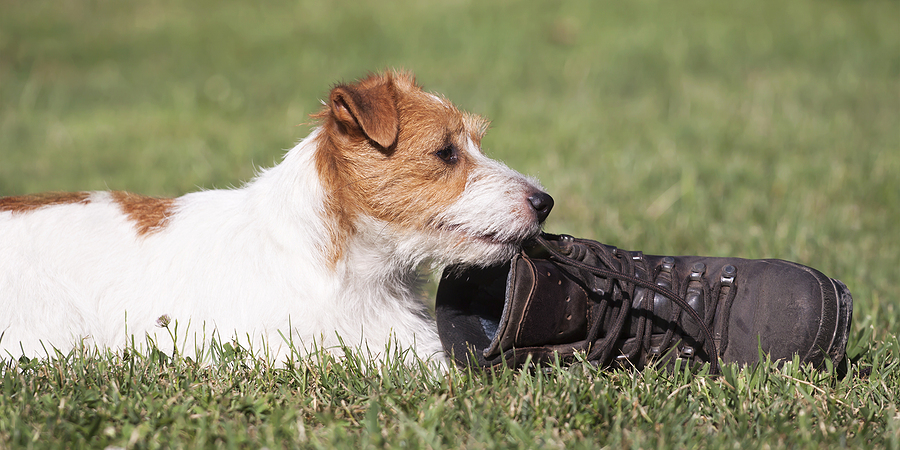Behaviors such as jumping, stealing, and chewing can be challenging to live with, whether this is your first dog or your fifth, but you can learn how to manage and prevent these behaviors and teach your dog new habits, setting your new dog up for success, and creating less frustration for both of you.
If you are a dog lover, chances are you have had one wonderful dog in your life, one who required minimal amounts of training to be successful with foundation behaviors and somehow understood that stealing off counters was inappropriate and jumping on humans was frowned upon. This “perfect” dog was beyond intelligent, completely bombproof, and will always be better than all the rest. The bond you shared with this dog will never be replicated.
When that dog goes and we have mourned their loss, our home feels empty, so we start looking for our next four-legged family member. This dog may be obtained as an 8-week-old puppy or adopted as an adult. This dog has some amazing qualities but doesn’t compare to the “perfect” dog. This dog has a different personality and learning history. Issues may include not coming when called, destroying items during alone time, and jumping excitedly on guests. With the right mindset, this dog can teach you to become patient, to “never slow down, never look back, live each day with adolescent spirit, spunk, curiosity and playfulness,” as dog lover John Grogan wrote in “Marley and Me.” Unfortunately, we don’t always see the positives in unruly behaviors. It’s easy to become frustrated with the dog, eventually destroying the human-animal bond. This article is about those not-so-perfect dogs.
Jumping
Jumping up on humans is a natural behavior in dogs. It may have developed as a greeting style because humans lack the natural traits dogs rely on for social interactions with other dogs: Our ears aren’t mobile and we don’t have tails or pheromones or glands that emit scent. But when dogs jump up, most humans try to push them down, ask them to perform another behavior, or scold them. The dog understands this as a form of attention and greeting from the human, not understanding that the person would like to be greeted in a different way.
- Management Suggestions
- Crate the dog before the guest enters the home. This will help to manage and potentially eliminate any chaos at the door.
- Use a Kong stuffed with high-value reinforcers such as peanut butter, canned dog food, and cream cheese to provide mental stimulation during crate time and keep the dog’s mouth busy while guests enter the home. If the dog’s mouth is busy, barking and arousal may be decreased, which will help when you start teaching appropriate behaviors.
- Keep the dog on leash at a distance from the door and distracted with some yummy treats. Keeping a distance from the guests’ entry can help eliminate excitement and set the dog up to offer more appropriate behaviors. Let the guest get settled and explain the rules for training with the dog in the home.
Stealing and Counter Surfing
Dogs who steal and counter surf are typically “people” dogs who enjoy attention from their owners and are driven by interactions with them. When they steal items or grab something off the counter, chances are the pet owner runs after the dog, yelling, screaming, or laughing. Those reactions strengthen the behavior. Counter surfing can also be a form of mental enrichment, causing dogs to work hard to find the next reinforcer (especially if food items have been stolen in the past).
- Management Tips
- Place a baby gate at the entrance to the kitchen to prevent the dog from entering and stealing food from counters.
- Keep the dog on leash or place the dog in a crate with food enrichment before the family spends time in the kitchen. This keeps the dog busy during meal preparation and can eliminate counter surfing.
- Keep all items on counters out of reach to eliminate the potential for accidental training sessions if management fails.
Chewing
Chewing is another normal canine behavior. It begins during the first few weeks of the puppy socialization period and sometimes continues throughout the dog’s life.
- Management Tips
- If the dog is chewing something inappropriate, replace it with a more appropriate item such as a chew toy or food enrichment toy to keep the pet engaged and mentally stimulated.
- Create barriers into rooms where chewing commonly occurs (if this is occurring with furniture, rugs, etc.). Baby gates and closing doors in the home can be beneficial in these situations.
It’s important to recognize that management is not a form of training and will not change the behavior itself. Management is a tool to use at times when training cannot occur or if the animal has high levels of stress or anxiety with the situation. Being consistent and eliminating opportunities to practice the behavior can help to prevent unwanted “training” sessions and decrease frustration and conflict.
As you work with your dog, keep the following quote in mind:
“Such short, little lives our pets have to spend with us, and they spend most of it waiting for us to come home each day. It is amazing how much love and laughter they bring into our lives and even how much closer we become with each other because of them.”–John Grogan
Dogs bring a large amount of love and laughter into our lives. Unruly behaviors can create many storm clouds and create tension and break that beautiful bond we have with them. Management and prevention can be immensely helpful in eliminating the storms and bringing forward the rainbows with these “not so perfect dogs.”
This article was reviewed/edited by board-certified veterinary behaviorist Dr. Kenneth Martin and/or veterinary technician specialist in behavior Debbie Martin, LVT.








